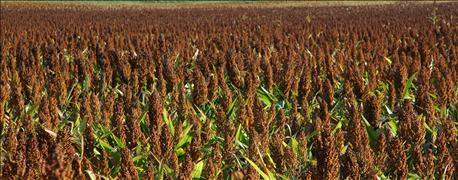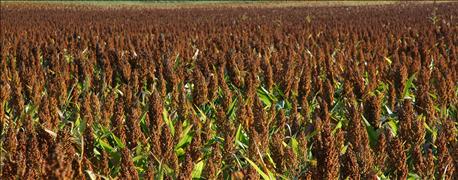
Delbert Knerr has never seen anything like the insect infestation in a grain sorghum farm field near Liberal, in southwest Missouri. "The amount of sugarcane aphids and armyworms, as thick as they were, over the entire crop field, was like nothing I have witnessed in all my life."
Knerr tried fighting them with insecticides this summer, but the damage was too much — and the University of Missouri Variety Testing Program project leader had no choice but to abandon the field trial.
"None of the other fields in the southwest trials experienced this level of insect issues," he notes. "But there was just something about the field."

GROWING GRAIN: Much of Missouri had an average grain sorghum harvest this year. However, in the southwestern portion of the state insects like sugarcane aphids and armyworms devastated fields.
The grain was actually maturing at the top of the milo head, according to Knerr. But the bottom of the head appeared softer. "Armyworms were eating on the grain on the lower half, and then the birds moved in," he recalls. The birds actually moved in to eat the armyworms, but then after eating the worms, they stayed and starting eating the grain left over. "The lower half of the head was basically gone," he says. The only thing left were leaves coated white from all of the bird manure.
A few neighboring farmers experienced the same problems, but they were localized. With the amount of damage from insects, the data from the site were so variable that Knerr did not include any of the information in the grain sorghum portion of the MU Variety Testing Program. However, there was one quirk that piqued the interest of this researcher.
An oddity
The insects left one test hybrid alone.
It was a very tall grain sorghum hybrid, reaching roughly 70 inches-plus in height. The stem extended 2 feet above the leaf material. On those plants, there was no insect damage. "I'm not sure if the bugs did not crawl up that high or what," Knerr says.
In hybrids that saw the most damage, insect fed on milo grain heads located right on top of leaves. The lack of space between the leaves and the head perhaps offered insects easy access to grain. The distance between the leaves and the grain head was the only difference between the hybrid with no insect damage and those that were wiped out by insects, Knerr notes.
"I don't know if that is a deciding factor, but it is something to look at," he adds. "I hope they enter it again next year. It was an interesting occurrence in this trial."

The norm
The rest of the state did not suffer from the same insect issues as the Liberal site. "I think it was an average year, as near as I could tell," Knerr says.
The grain sorghum test was to be conducted at five locations across the state: Mooresville, Columbia, Montrose, Liberal and Charleston. As Knerr notes above, however, the Liberal location was abandoned.
Topping the test on an individual hybrid basis was Dyna-Gro GX15672 at 135.4 bushels per acre, in Mooresville. The top-yielding milo hybrid on average for the entire state of Missouri was Dekalb DKS53-53, with an average yield of 109.3 bushels over the four locations.
"A 100-bushel-per-acre average is a good average for milo," Knerr says. "In Mooresville alone, 16 of 18 hybrids yielded above 100 bushels."
Last year, the MU Variety Testing Program did not even plant grain sorghum test plots because there was only one entry. However, in 2014 there were 25 entries. This year the trials collected data on 19 hybrids. "I think commodity prices have some farmers looking to the crop again," Knerr says. "And milo seems to be fairly consistent with its pricing. I think that is sparking some interest."
About the Author(s)
You May Also Like






